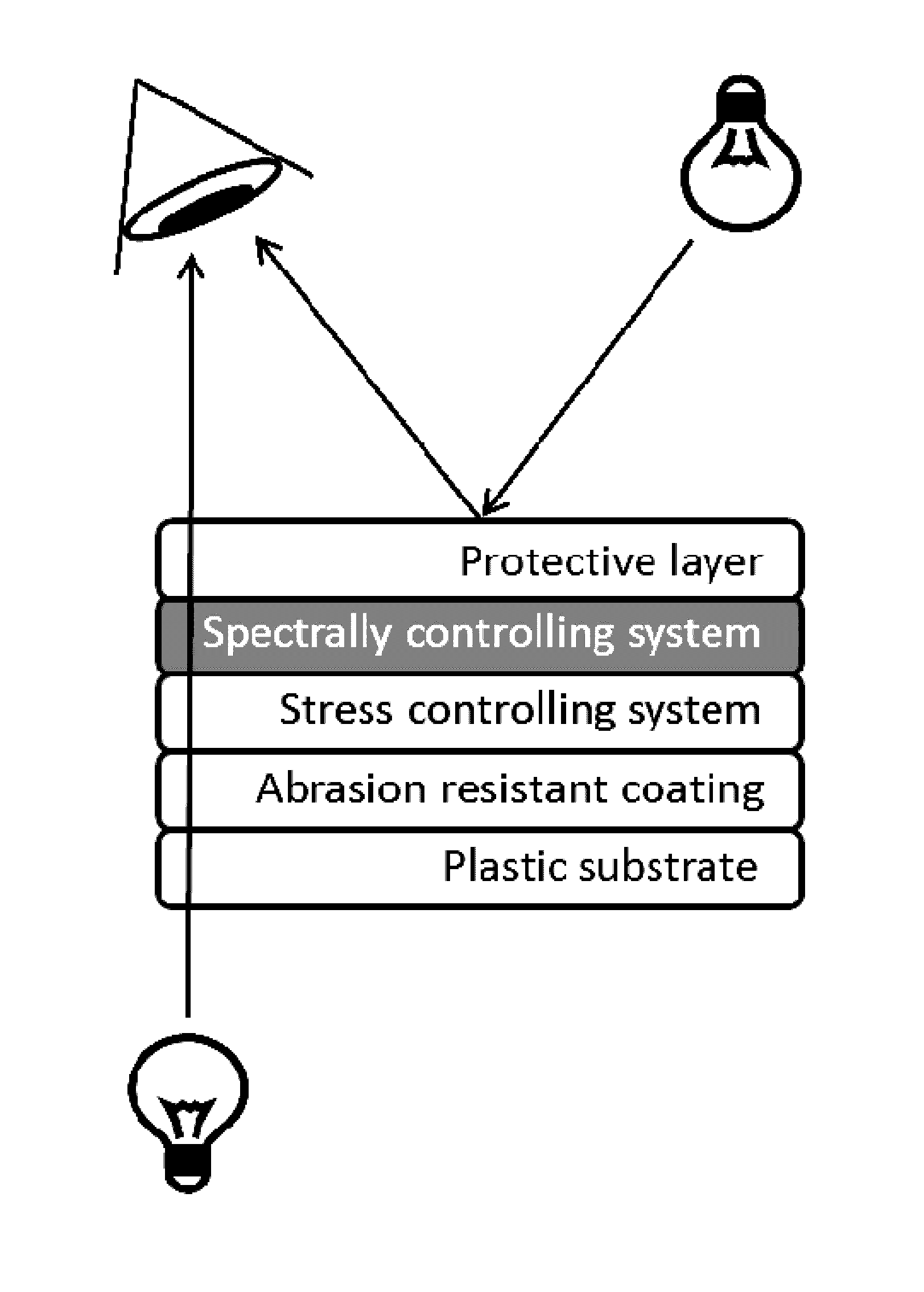Decorative coatings for plastic substrates
- Summary
- Abstract
- Description
- Claims
- Application Information
AI Technical Summary
Benefits of technology
Problems solved by technology
Method used
Image
Examples
example 1
Desired Optical Effect—Piano Black Spectrally Reflected Appearance with High % T
[0072]An injection moulded polycarbonate substrate is first cleaned through a commercial ultrasonic cleaning system with detergent. A final rinse in distilled water is required in a clean (dust free) environment. The substrate is then dip coated in a Momentive PHC-587B at a withdrawal rate of 10 mm / s. A flash-off time of 10 minutes allows solvents to slowly evaporate and the part to be largely tack free. The substrate is then moved to a curing oven for 45 minutes at 130° C. Subsequent coatings are performed within a 48 hour period so as to avoid aging / contamination of the hardcoating.
[0073]The substrate is loaded into a batch type vacuum sputter coater, (PylonMET VXL) which consists of a single coating chamber in which the samples are placed, evacuated and coated. Within this chamber the samples were evacuated to a pressure below 8 ×10-5mbar. There was a target to substrate distance of 110 mm and the fol...
example 2
Desired Optical Effect—Bright Chrome with High % T
[0079]A process generally as described in Example 1 is employed, with the following alterations.
[0080]Spectrally Controlling System
Layer 1Layer 2MaterialCrZrSiO2Thickness (nm)2515
[0081]The measured residual stress of layers was determined, the durability performance was tested, and the actual optical measurements obtained. The results are set out in Tables 4, 5 and 6 below.
TABLE 4Measured stress of the layersLayerStressStress controlling system−260 MPaTotal residual stress−160 MPa
TABLE 5Durability PerformanceTest DurationResultAbrasion resistance300cyclesAbrasion(Bayer)ratio = 15Thermal Shock200cyclesPassDry heat Test115°C.PassAccelerated UV2500kJ / m2Passweathering (SAE J1960)
TABLE 6Optical Measurement Data (Desired Optical Effect)Photopic reflectionY = 55.3%Photopic transmissionY = 7.2%Reflected colour target on transparentL* = 79.2substrate - CIE L*a*b* scale measured witha* = −0.8illuminant A / 2b* = 0.72Transmitted colour target on ...
example 3
Desired Optical Effect—Opaque Gun Metal (for Illuminated Patterns)
[0082]A process generally as described in Example 1 is employed, with the following alterations. However, it should also be noted that the sample is ‘vented’ between application of the stress controlling system and the spectrally controlling system for metal ablation / removal to enable the illuminated pattern (also referred to as “hidden 'til lit”) functionality. A schematic representation of a coated substrate in accordance with this embodiment is illustrated in FIG. 2.
[0083]Stress Controlling System
Layer 1Layer 2Layer 3Dual rotatablePower 35Power 31Silicon TargetkW @kW @99.90%27 kHz27 kHzChrome Zirconium—Power 60—Target 98.5% / 1.5%kWTotal Gas flowArgon 160Argon 150Argon 96sccmsccmsccmOxygen 302Nitrogen 90Oxygen 202sccmsccmsccmRPM8.42424Number of rounds3634 3Base Pressure2e−52e−52e−5(mbar)Run Pressure2e−32e−32e−3(mbar)Thickness (nm)250115 15
[0084]Spectrally Controlling System
Layer 1Layer 2Layer 3Layer 4Layer 5MaterialS...
PUM
| Property | Measurement | Unit |
|---|---|---|
| Nanoscale particle size | aaaaa | aaaaa |
| Transparency | aaaaa | aaaaa |
| Stress optical coefficient | aaaaa | aaaaa |
Abstract
Description
Claims
Application Information
 Login to View More
Login to View More - R&D
- Intellectual Property
- Life Sciences
- Materials
- Tech Scout
- Unparalleled Data Quality
- Higher Quality Content
- 60% Fewer Hallucinations
Browse by: Latest US Patents, China's latest patents, Technical Efficacy Thesaurus, Application Domain, Technology Topic, Popular Technical Reports.
© 2025 PatSnap. All rights reserved.Legal|Privacy policy|Modern Slavery Act Transparency Statement|Sitemap|About US| Contact US: help@patsnap.com



